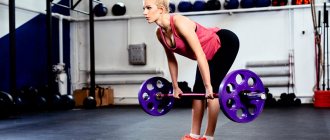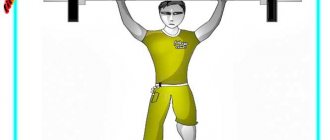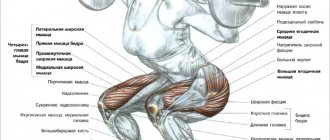Negative Reps: The Key to Strength and Mass!
Admin
Hello friends! Well, now it’s hard to call you a beginner, unless of course you’ve read what a drop set, a superset, a triset, a giant set and a wedge approach are, today we’ll talk about this method of influencing muscles as a negative.
What are negative repetitions
NEGATIVE REPS – a muscle training scheme in which the main load is placed on the phase of lowering the weight.
The point of the exercise is that the trainee devotes a minimum of effort to the weight lifting phase, all concentration of attention and strength is directed to the negative phase, that is, lowering.
To do this, you simply need a training partner, although there are exercises in which you can do without one, for example:
— lifting a dumbbell on a Scott bench, you help the lifting phase with your second hand, and lower it exclusively with one working hand;
- it is also good to do reverse pull-ups on the bar, hanging a large weight on your belt, using a stand, stand on it so that the bar is at neck level, then lower yourself down solely on your hands in a slow manner.
But still, in most cases, without a partner, a negative will be a negative, and we need a mega-negative.
The use of negatives allows you to work with extreme weights that have not been used before, due to this the muscles experience extra stress and shock, and this affects the growth of strength and muscle volume.
The benefits of negative repetitions
Using the negative method, the muscle fibers are greatly stretched, lifting the weight; on the contrary, they contract; due to the constant action of the “accordion” effect, the muscles are damaged, receiving micro-tears, the healing process of damaged tissues is activated, and this is mass growth.
Training with negative approaches requires more recovery time for muscle fibers, since the damage is greater than with regular training.
Do not use negativity just like that, turn it on only when the growth of the mass has stopped and complete “stagnation” has occurred.
Negative reps in bodybuilding
» Be sure to warm up your body well before starting the exercise , light jogging, jumping rope, exercise bike, and after stretching, you can choose another aerobics, there is a whole section dedicated to this on this site;
“ Always do 1-2 warm-up approaches , the weight of the projectile should be 40-50% of the maximum weight (maximum weight is the weight with which you will do a maximum of 1 repetition of lifting and lowering and no more) to prepare the body for combat readiness;
“ The beginning of the negatives should start with the maximum weight for you , add another 5-10% to it - this will be the weight of the projectile for further work;
“ You need to lower the weight within 5 seconds ; if you do it faster, increase the load; less, decrease it.
Negative repetition method features
→ Must be performed only by those who have solid training experience and no pain in the elbows and knees , since they are subject to a large load, they are the main connecting part between the trained muscle and the weight of the projectile itself;
→ Do not do it more than 1-2 times a month , otherwise the muscles will become exhausted, they will get used to the load and the benefits will decrease;
→ Always lower the weight yourself , this is the only way to achieve maximum results;
→ When performing negative approaches, make sure that there is good balance , for example: bench press, seated press or squats, it is better to do it in a Smith machine, so you will fully concentrate on the weight and the muscle being trained, you will pay less attention to stabilizing the torso, and therefore waste energy.
conclusions
Use negatives as an ice shower for your muscles, just don’t forget, everything needs moderation, more is not always better. They can be used for both basic and isolation exercises. Train and be big ???? .
Negative repetitions Source: bombatelo.ru
This is interesting: Insanity - Sean Ti program: second cycle
Are negative reps any good?
Negative repetitions are self-deception: the athlete begins to believe that he can perform more repetitions, although in fact he performs some of them not on his own, but with, albeit a little, help from a partner. Therefore, the results and progress that the athlete attributes to himself are not completely reliable and do not reflect the real picture.
It makes sense to resort to the help of a partner only when there is not enough strength to complete the climb. Then the partner must quickly raise the bar to the “off” point. However, a different situation often occurs: the athlete is first helped to lift the weight and overcome the sticking point, and then perform additional repetitions together. With each repetition, the support increases more and more, which means the athlete works less and less.
Nowadays, some trainees perform almost all exercises with outside help. But in order to develop muscles, you need to give the load specifically to them, and not to the muscles of your partner. You can be proud of lifting heavier weights. But it is difficult to imagine a picture when an athlete who did not reach the finish line is carried in his arms, and then the result is credited to him. Why do many people allow themselves to do this when working with a barbell?
Negative repetitions
Negatives
or
negative repetitions
(sets) are an effective method of increasing training intensity, building muscle mass and strength. Negative reps are also effective when you feel stagnant in your training.
This method consists in the fact that when performing an exercise, the trainee practically eliminates the positive phase of the repetition (lifting weights) and leaves only the negative one (lowering weights). For example, when performing the popular basic exercise, the bench press using the negative method, you only slowly lower the barbell to your chest on your own, and lift it with the help of your partner.
The use of the negative method in training allows you to significantly increase working weights, since in the negative phase the muscles are able to develop significantly greater force. The main condition for using the negative repetition technique is the help of a partner who helps you lift the weight, and you, in turn, spend less energy on the positive and give all your best in the negative phase.
In some exercises, negativity can be performed without the help of a partner, on your own. These are all exercises that are performed with one arm or leg. For example, doing dumbbell bicep curls. The positive phase of the exercise (lifting the dumbbell to the top point) is performed with two hands, and the negative phase (lowering) with one.
The negative method without the help of a partner can also be used in leg curls, leg extensions and leg presses.
In pull-ups, you can stand on a high stand so that your chin is above the bar, then, with your legs tucked, slowly lower yourself into a hanging position, then stand on the stand again and repeat all the steps to perform the next negative repetition. In dips, the same technique is used to perform the exercise.
The benefits of negatives
Positive exercises are those that cause a shortening of muscle length, while negative exercises are accompanied by muscle stretching.
When you lift heavy weights, your muscles contract and become shorter. As you slowly lower the weight, your muscles again become very tense under the influence of gravity, but at the same time their stretch increases (they lengthen). The muscles receive enormous stress from this unnatural position, and muscle fibers are torn. As a result, the healing mechanism of damaged muscles is activated, which leads to increased muscle growth. It turns out that by focusing on performing the negative phase of the exercise, you spur your muscles to grow.
Negative reps are very effective at challenging your muscles, giving them maximum stress. And after performing negative reps, it will take you much longer to recover your muscles.
Despite the benefits you get from using negative repetitions, it is not recommended to use them as the basis of your training, since they do not involve the positive phase of training, which you also need. It is necessary to use negative repetitions when you have not made progress for a long time and you feel that your muscles are not receiving an “explosive” load. Negatives will certainly wake them up and remind them of what real stress is!
Weight recommendation
You need to start performing the exercises with a weight that is your maximum, since negative repetitions with your working weight when the negative phase is delayed for several seconds will not bring any effect. The maximum is calculated in terms of the maximum weight you can perform one repetition (one rep) without support. To this maximum you need to add another 5% of the weight, that is, for example, if you bench press a maximum of 100 kg, then start with a weight of 105 kg.
Try to complete the first negative repetition in 8 seconds. If you do it in 3 seconds, then the weight is too high. The negative phase should take 4–8 seconds.
Execution order
To perform negative reps, athletes must have sufficient experience and a solid base, as negatives place a lot of stress on the elbows and shoulders.
If you have just started working with negatives, it is better to do them once every few weeks. With more frequent use of negative repetitions, there will be a decrease in efficiency and the muscles will get used to such a load.
When performing negatives, you push the weight out in a traditional manner and lower it in a slow motion. Of course, this technique requires a maximum working weight, which you lift together with a training partner. Lowering the weight is done only independently, as slowly as possible.
Perform negatives in the amount of 2-3 approaches in the first exercise. Prolong the negative phase to 4–8 seconds. Try to complete as many repetitions as you can manage, as the number is not important here.
Attention : you should perform negatives only in simulators!
Examples of negative repetitions
For negatives, exercises such as overhead rows to the chest, bench press, seated press, leg curls and straightening in the simulator, and biceps curls are perfect.
Source: dailyfit.ru
What are negative repetitions
Negative reps are a high intensity training method in bodybuilding. Its essence is that the concentric phase is almost completely excluded from the exercise, and only the eccentric phase remains. The concentric phase is usually called the raising of the projectile, and the eccentric phase is its lowering.
Why are negative repetitions needed and what benefits do they bring?
Performing “negatives” allows you to work with a large working weight, thereby enhancing the work of the desired muscle in the eccentric phase. This approach leads to explosive muscle growth. This type of exercise is especially effective when there is a certain stagnation in training, when increasing weight becomes impractical and even dangerous. According to research data, after just 1 week of negative training, strength indicators increase by 10-20%.
Please note: Negative reps are not suitable for beginner athletes. They should only be performed by those people who have been practicing for at least 2-3 years. When implementing them, you cannot do without the help of a strong partner.
It is not recommended to use this type of training on an ongoing basis. Include it in your program once every 5-6 months to achieve maximum results without having to get used to unusual loads for the body.
Negative repetitions
Source: 4rama.com
This is interesting: Squats with dumbbells: correct technique, practical recommendations for performing and including exercises in the training program, scheme for performing squats with dumbbells in hands
Why are negative reps needed in bodybuilding and powerlifting?
Author: Timko Ilya - the ruler of the entire site and fitness trainer | more details >> Rod. 1984 Trained since 1999 Trained since 2007. Author and creator of the site tvoytrener.com. CCM in powerlifting. Champion of Russia and South Russia according to AWPC. Champion of the Krasnodar region according to IPF. 1st category in weightlifting. 2-time winner of the Krasnodar Territory championship in t/a. Author of more than 700 articles on fitness and amateur athletics. Author and co-author of 5 books.
Place in the ranking of authors: out of competition
(become an author)
Date of:
2014-02-16
Views:
12,994
Rating:
5.0
| All articles by the author >> | Medals articles >> |
Articles are loading...
Before we begin the harsh practice, a little theory. During any exercise, muscles perform three types of work.
1. Overcoming. When you lift a projectile against gravity. The vast majority of training is based on this type of work.
2. Static. When the projectile is in one position. That is, for example, when you hold the barbell motionless at some point in the trajectory of movement. This method was widely used in his training by the famous Alexander Zass.
3. Inferior. When, under the influence of the gravity of the projectile, it is lowered down.
It is precisely the third type of work that is key in negative repetitions. Now I will try to define this training method.
Negative reps are reps where there is a SLOW and CONTROLLED lowering of the apparatus or your own body. Moreover, the weight or muscle fatigue should be such that you are unable to lift the apparatus.
From this definition it is clear that in order to effectively use negative repetitions, either the weight must be extreme (that is, you cannot do overcoming work with it), or the muscles must be tired so that, again, you cannot lift this weight.
Based on this, two purposes of negative repetitions can be distinguished:
- Increased muscle mass.
- Increased muscle strength.
Increased muscle mass
This is precisely the second case described in the definition. It is used primarily in bodybuilding. And you can do most exercises with it. Here's an example. You do 30kg barbell biceps curls for 10 reps. You do the tenth repetition with all your strength. And then slowly and under control lower the barbell down for 5 to 10 seconds. You can not limit yourself to one repetition, but ask your partner to lift the barbell up for you and do several more such repetitions.
The essence of the effect is that in this way you can put more stress on the muscles. And the stronger the stress, the better your muscles respond to the load. After all, it is such extreme stress that makes them grow.
In my practice, I widely use this method in pull-ups. When a person, after the last pull-up, goes down very slowly (up to 30 seconds). This approach allows you to increase the number of pull-ups.
Increased muscle strength
This is the first case described in the definition. And it is usually used in powerlifting. You can only do basic exercises this way. Let's take the bench press as an example. Let's say you can bench press a maximum of 100 kg one time. You put 115 kg on the barbell and slowly (the same 5 - 10 seconds) lower it to your chest. It's like you're resisting the weight of the barbell. Naturally, the assistants return the bar to the racks.
This method is practiced by powerlifters usually in squats, deadlifts and bench presses. Moreover, the weight of the projectile must necessarily be greater than your maximum. By about 10% - 20%. Otherwise there will be no point. You can perform either 1 or 2 – 3 repetitions. Personally, I don’t practice more than 3 repetitions.
What is the essence of the effect here? Why are your muscles getting stronger? For those who know human physiology, there is no mystery here. The pressure that the weight of the projectile exerts on your body and your muscles causes a corresponding signal that is transmitted first to the brain and then through the motor neurons to the muscles. And the strength of muscle contraction directly depends on the strength of this signal. And the strength of the signal directly depends on how much weight is pressing on your muscles. By the word “presses” I mean the force of impact, and not in the literal sense.
And here we come to the key point. When you lift more weight than you can lift, the strength of the signal sent to your muscles is greater than ever before. And this signal causes your muscles to contract with a force that they cannot develop with inferior work.
If we take the maximum muscle contraction during overcoming work as 100%, then during static work the muscles can contract by 110% - 120%. And when inferior by about 130%.
conclusions
Negative reps can be both good variety for your workouts and a good way to make your muscles bigger and stronger. But I wouldn't recommend this method for beginners. As for the growth of mass, it will continue to grow for the first time. And if it doesn’t grow, then negative repetitions are unlikely to help in this case, and you need to look for the problem elsewhere. As for increasing strength, the joints and tendons of beginners are simply not ready for such extreme loads. After all, supermaximal weights pose a high risk of injury.
Also, you don’t need to use negative reps in every workout. How often, I cannot say. See for yourself here. Good luck.
By the way, you can order yourself an individual set of exercises from Timko Ilya, the author of this article and this site.
Rate the material:
Found an error in the article? Select it with the mouse and press Ctrl + Enter . And we will fix it!
| SHARE | WE ARE IN SOCIAL NETWORKS |
Best articlesNew articles
Source: tvoytrener.com
Negative reps for experienced athletes
Negative reps will benefit experienced athletes who already have some results. In the absence of a base, it is better, instead of negative exercises, to increase the total load during training, that is, perform more approaches or repetitions with less weight. Then all the necessary muscles will work, and the weaker ones will tighten up. If you immediately resort to the help of a partner, then weak muscle groups will not develop. You should not start working with a partner until the athlete can independently lift at least 150 kg.
In addition, negative repetitions put a lot of stress on the shoulders and elbows. For beginners, they may simply not be able to stand it.
Negative repetitions take a lot of effort and time. Therefore, it is rational to include negative repetitions in the training for only one muscle group and carry out such training for, for example, a month. Then after a break (several months) move on to another muscle group. So in a year you can more carefully focus on each muscle group twice.
Super moves for super muscles! Increasing working weights and muscle mass
As you already know, the main iron rule of bodybuilding is load progression. There are a huge number of ways to increase it. I'm sure you will be interested to know how diverse they are.
Hello friends. Today we will talk about “super techniques” that I really like to use to increase the load.
We talked about increasing the number of repetitions and working weights (about linear progression of the load) in the last article about how to increase working weights in exercises. If you haven't read it, I highly recommend it.
But this method of increasing the load only works up to a certain point.
Yes, the principle itself remains: make the load larger than it was before, but there are a huge number of ways to increase it. Let's talk about the main ones.
Ways to increase the load and super techniques
As I said, increasing the number of repetitions and weight on the bar are not the only ways that can make our training more difficult.
At a certain stage, these methods practically stop working, and progress slows down significantly.
This happens to everyone, without exception.
What to do next?
Develop other systems in parallel and increase the load in other ways.
Reducing rest between sets
A very popular way to increase the load.
Its essence is simple: from training to training, you reduce the rest between approaches.
For example, you are training your chest today. Do dumbbell presses on an incline bench. In order to start increasing the load in this way, you will need a watch with a stopwatch or an application on your phone, it doesn’t matter.
You’ve done one approach, immediately turn on the timer and time the rest between approaches.
Let's say you did one set, rested for 90 seconds before the next one. Fine. We wrote this whole thing down in our training diary.
We repeated the same thing in each approach.
The point is that you have fixed and know what parameter you should work on.
Now you understand that in order to increase the load you need to reduce a specific number, namely 90 seconds.
At the next chest workout, you no longer rest for 90 seconds, but for 80-85 seconds, etc. Then 75, then 70, 65 and so on.
I think there is nothing more to explain here. Let's move on to the next method.
Increasing the number of approaches to exercises
Another good way to increase your training load.
This method works both individually and in combination with reducing rest between approaches.
I don't share the popular belief that you can only exercise for 45 minutes, read my article on how long you can exercise. Therefore, increasing the number of approaches works on its own.
I like to use a method used in weightlifting, which is to count the number of barbells lifted (and the kilograms on them).
Let's say (chest training):
- Incline Dumbbell Press: 4 x 6-12 reps.
- Guillotine style barbell press (bar lowered to the throat): 4 x 6-12 reps.
- Crossover from low rollers, lying on an incline bench: 4 x 8-15 reps.
Let's say your working weight in these exercises is:
- Dumbbells 30 kg.
- Barbell 80 kg.
- Crossover 20 kg.
Total number of approaches: 4+4+4 = 12.
Using the example of an incline dumbbell press, I will explain for you the total weight, depending on the number of barbells lifted.
Let's say you did 4 sets with dumbbells of 30 kg each (i.e. 60 kg total weight):
- In the first set you did: 9 reps.
- In the second set you did: 8 reps.
- In the third: 7 repetitions.
- In the fourth approach: 6 repetitions.
What is the total weight you lifted in 4 sets of this exercise?
Using simple mathematical operations we find out:
60*9+60*8+60*7+60*6 = 1800 kg.
And this is only for the first exercise.
By adding one more approach, the amount of kilograms lifted and the number of barbells lifted will increase and, accordingly, the volume of load in the workout will increase.
Also, you can first count the number of barbells (or dumbbells) lifted and multiply it by the weight on the barbell (assuming the weight was the same):
9+8+7+6 = 30 PG
PG = raised dumbbells, PB = raised barbells.
And then multiply this amount by the weight on the projectile, i.e. 30*60 = 1800 kg.
This number must be calculated for each exercise in order to understand the number that needs to be increased.
When you reach a certain point where you are no longer able to increase the load linearly (the weight on the apparatus does not increase), you can increase the volume of the workout itself, by increasing the sets or the number of apparatus lifted, which is the same.
All this can be used in total with a reduction in time between approaches.
Let's say your workout takes 60 minutes.
If you add 1-2 more sets of exercises with the same rest time between sets, your workout will become a little longer, say 5-10 minutes.
You can reduce the rest time between approaches, say by 5 seconds, and then you will be able to complete approximately the same workout time as before, but the load will increase significantly.
Increasing the number of exercises per workout
The same as in the previous method, only increasing the load by increasing the number of exercises per workout.
It makes sense to use it if you have already increased the number of approaches in each exercise to 5-7 or you just want to diversify your program a little.
I don’t see any point in explaining in detail, because... everything is extremely simple.
When you have reached 5-7 approaches in each exercise, you have significantly reduced the rest time between approaches, you can add 1-2 more exercises.
And then, as before, we count the number of projectiles lifted and the total tonnage per training, which we try to increase.
Cheating
It belongs to super techniques and can also be one of the ways to increase the load in training.
Cheating is a deliberate violation of the technique of performing an exercise in order to lift more weight or increase the number of repetitions or approaches.
I would like to warn you right away that cheating is not a technique for beginners, but ONLY FOR EXPERIENCED ATHLETES!
Beginners do not yet have such heavy weights and, as a rule, have problems with the technique of performing exercises. There is no talk of any CONSCIOUS VIOLATION of technology.
There is a big risk in this method of increasing the load, and in many exercises it is better not to use this method at all, for example, in squats. You can end up with a sore back.
The essence of the method is simple.
Let’s say if you do 8 reps of barbell curls, and then you can’t lift the weight with the proper technique. Your working weight and number of repetitions have plateaued. What to do?
You can use cheating. Do 9 repetitions with a slight violation of technique (lean back a little, slightly tuck the weight with your hands, etc.).
Over time, after 1-2 workouts, you will be able to do the 9th repetition cleanly.
Supersets
A superset (super series) is a combination, as a rule, of two or more (less often) exercises and performing them one after another without rest.
For example, you perform a barbell curl, and after finishing the approach, immediately perform a French press without rest.
Those. consistently use antagonist muscles (performing opposite functions).
This method at a certain stage provides a lot of advantages for the following reasons:
- Reduce training time (saving time).
- You use active rest (during rest, the antagonist does not just wait for his turn, but is washed with nutrients, which allows you to maintain a high concentration of growth factors).
- Improve your endurance (in addition to increasing muscle mass, your body becomes more resilient)
The method is also not for beginners, but over time, you can also add this method to your training.
By the way, from the very beginning of my training I did not know how to train and my first program included supersets. It didn't make me any worse, just better.
Drop sets
Drop sets are sets with weight loss.
Let's say you're doing an incline dumbbell press.
You can simply perform 4-5 sets with a working weight, say 30 kg dumbbells, and then use a drop set. After completing the last working approach, you immediately, without rest, take 25 kg of dumbbells, then 20, and then 15, etc.
Those. acidification does not allow you to perform another contraction with the same weight, but by reducing it you can do a few more repetitions. Accordingly, the load increases through deeper muscle exhaustion and acidification.
You can also just do each set in a drop style, but be careful. If you are doing this for the first time, then you should not do this. There is a high risk of overtraining.
Negative repetitions
There are two variations of them.
- Slowing down the movement in the negative phase of the exercise.
- Controlled lowering of the weight in the negative phase.
So. Each exercise has a positive and negative phase.
Let's say in the bench press you press the weight up - this is the POSITIVE PHASE. And when you lower it, it is a NEGATIVE PHASE. It's simple.
So here it is. This is true in every exercise.
The first way is to quickly press the barbell up and lower it much more slowly (extend the negative phase). You press the barbell up for 1-2 seconds, and lower it for 3-5 seconds, for example.
The second way is to press the barbell at your usual pace, but then when positive failure occurs (you can’t press the barbell any more), your friend helps you lift it (in fact, he lifts it up for you), and you try to lower it under control down until it simply falls on your chest, and the chest is no longer able to contract.
This is called negative refusal, and the repetitions themselves are NEGATIVE.
X-Reps repetitions (partial amplitude)
X-reps (or partial range of motion reps) are a technique where the athlete performs repetitions WITHIN the AMPLITUDE of movement of the apparatus, i.e. in the strongest phase of muscle contraction.
The point is that it is not beneficial for our body to perform movements in full amplitude, because... it's much more complicated.
When we perform barbell curls, we always want to stop the exercise at the bottom with bent elbows, and not straighten our arms completely, because with full extension of the elbow joint, the next repetition will force the biceps to contract, using first its weaker part (the place of attachment to the elbow), which will take more energy than when working within the amplitude (when only the strong part of the muscle works).
Working within the amplitude, we can work with more weight, which gives us the opportunity to progress the load by increasing the working weights.
Plus, this way of doing the exercise is much safer, because the load is removed from the joints.
But there is another advantage, namely, crazy blood supply to the muscle, because. the “pump principle” works (blood enters the muscle, but does not leave there, because the outflow of blood is compressed).
This method of progression of loads also takes place.
Pre-fatigue
The method is very useful when you have reached very heavy weights in the exercises.
Let's say you squat with a barbell of 200 kg, and then your knee joints begin to ache. You are afraid of getting injured, but you still want to grow. What to do?
Use pre-fatigue of muscles.
The point is simple.
You perform some kind of isolation exercise before doing the basic exercise. Let’s say you’re doing leg extensions in a machine.
You do 3-4 sets, getting your quads well pumped with blood, and then go squat.
But you are unlikely to be able to reach the previous weight, because... the muscles are no longer fresh and rested, but tired.
You take 170-180 kg and squat.
The weight is familiar to your body and safe for the joints, but the progression of loads is still present, because... Before this, you performed additional insulation.
Progressing the load is very simple:
- Increase the weight in machine leg extensions (i.e., in an isolation exercise).
- Gradually increase the weight in the basic exercise (squats).
- Increase the number of repetitions and approaches in the isolation exercise.
- Increase the number of isolating pre-exhausting exercises.










